The Cambridge History of Japan, Vol. 3: Medieval Japan
Подождите немного. Документ загружается.

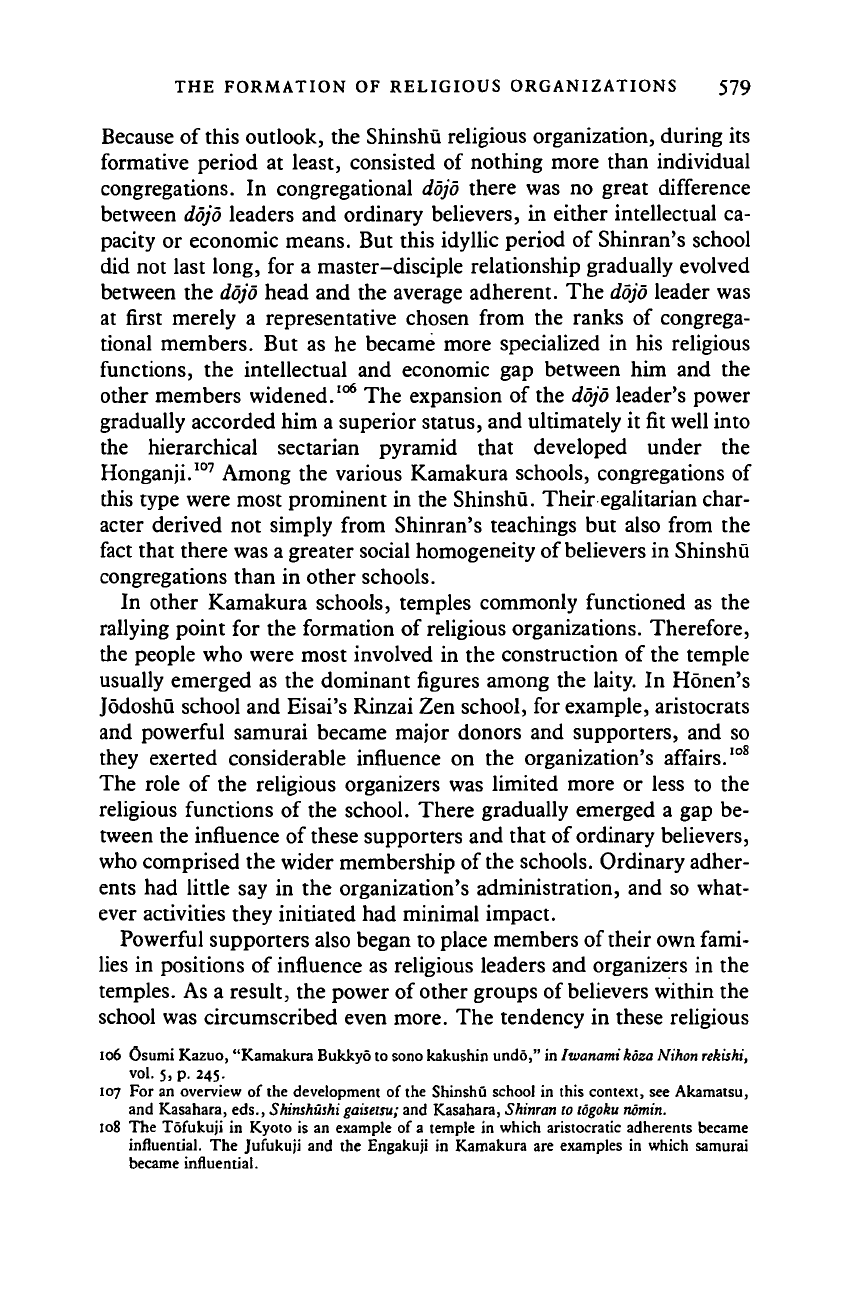
THE FORMATION OF RELIGIOUS ORGANIZATIONS 579
Because of this outlook, the Shinshu religious organization, during its
formative period at least, consisted of nothing more than individual
congregations. In congregational dojo there was no great difference
between dojo leaders and ordinary believers, in either intellectual ca-
pacity or economic means. But this idyllic period of Shinran's school
did not last long, for a master-disciple relationship gradually evolved
between the dojo head and the average adherent. The dojo leader was
at first merely a representative chosen from the ranks of congrega-
tional members. But as he became more specialized in his religious
functions, the intellectual and economic gap between him and the
other members widened.
106
The expansion of the dojo leader's power
gradually accorded him a superior status, and ultimately it fit well into
the hierarchical sectarian pyramid that developed under the
Honganji.
107
Among the various Kamakura schools, congregations of
this type were most prominent in the Shinshu. Their egalitarian char-
acter derived not simply from Shinran's teachings but also from the
fact that there was a greater social homogeneity of believers in Shinshu
congregations than in other schools.
In other Kamakura schools, temples commonly functioned as the
rallying point for the formation of religious organizations. Therefore,
the people who were most involved in the construction of the temple
usually emerged as the dominant figures among the laity. In Honen's
Jodoshu school and Eisai's Rinzai Zen school, for example, aristocrats
and powerful samurai became major donors and supporters, and so
they exerted considerable influence on the organization's affairs.
108
The role of the religious organizers was limited more or less to the
religious functions of the school. There gradually emerged a gap be-
tween the influence of these supporters and that of ordinary believers,
who comprised the wider membership of the schools. Ordinary adher-
ents had little say in the organization's administration, and so what-
ever activities they initiated had minimal impact.
Powerful supporters also began to place members of their own fami-
lies in positions of influence as religious leaders and organizers in the
temples. As a result, the power of other groups of believers within the
school was circumscribed even more. The tendency in these religious
106 Osumi Kazuo, "Kamakura Bukkyo to sono kakushin undo," in Iwanami koza Nihon rekishi,
vol.
5, p. 245.
107 For an overview of the development of the Shinshu school in this context, see Akamatsu,
and Kasahara, eds., Shinshushi
gaisetsu;
and Kasahara, Shinran to wgoku nomin.
108 The Tofukuji in Kyoto is an example of a temple in which aristocratic adherents became
influential. The Jufukuji and the Engakuji in Kamakura are examples in which samurai
became influential.
Cambridge Histories Online © Cambridge University Press, 2008
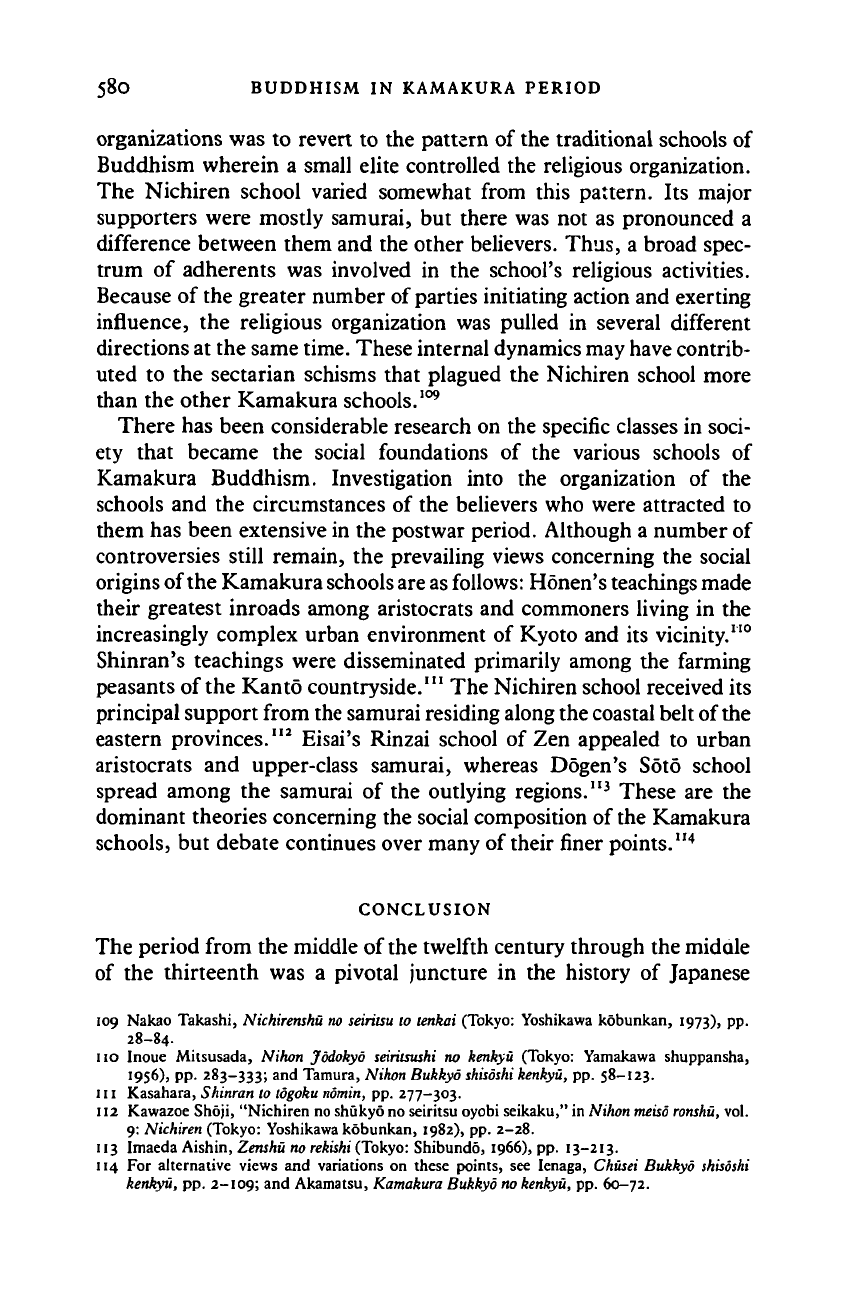
580 BUDDHISM IN KAMAKURA PERIOD
organizations was to revert to the pattern of the traditional schools of
Buddhism wherein a small elite controlled the religious organization.
The Nichiren school varied somewhat from this pattern. Its major
supporters were mostly samurai, but there was not as pronounced a
difference between them and the other believers. Thus, a broad spec-
trum of adherents was involved in the school's religious activities.
Because of the greater number of parties initiating action and exerting
influence, the religious organization was pulled in several different
directions at the same
time.
These internal dynamics may have contrib-
uted to the sectarian schisms that plagued the Nichiren school more
than the other Kamakura schools.
109
There has been considerable research on the specific classes in soci-
ety that became the social foundations of the various schools of
Kamakura Buddhism. Investigation into the organization of the
schools and the circumstances of the believers who were attracted to
them has been extensive in the postwar period. Although a number of
controversies still remain, the prevailing views concerning the social
origins of the Kamakura
schools are as
follows: Honen's teachings made
their greatest inroads among aristocrats and commoners living in the
increasingly complex urban environment of Kyoto and its vicinity.
110
Shinran's teachings were disseminated primarily among the farming
peasants of the Kanto countryside.
111
The Nichiren school received its
principal support from the samurai residing along the coastal belt of the
eastern provinces.
112
Eisai's Rinzai school of Zen appealed to urban
aristocrats and upper-class samurai, whereas Dogen's Soto school
spread among the samurai of the outlying regions.
1
'
3
These are the
dominant theories concerning the social composition of the Kamakura
schools, but debate continues over many of their finer points."
4
CONCLUSION
The period from the middle of
the
twelfth century through the midale
of the thirteenth was a pivotal juncture in the history of Japanese
109 Nakao Takashi, Nichirenshu no seiritsu to tenkai (Tokyo: Yoshikawa kobunkan, 1973), pp.
28-84.
no Inoue Mitsusada, Nihon Jodokyo seiritsushi no kenkyu (Tokyo: Yamakawa shuppansha,
1956),
pp. 283-333; and Tamura, Nihon Bukkyo
shisoshi
kenkyu,
pp. 58-123.
in Kasahara, Shinran to
logoku
nomin,
pp. 277-303.
112 Kawazoe Shoji, "Nichiren no shukyo no seiritsu oyobi seikaku," in Nihon
meiso
ronshu,
vol.
9: Nichiren (Tokyo: Yoshikawa kobunkan, 1982), pp. 2-28.
113 Imaeda Aishin, Zenshu no
rekishi
(Tokyo: Shibundo, 1966), pp. 13-213.
114 For alternative views and variations on these points, see Ienaga, Chusei Bukkyo
shisoshi
kenkyu, pp. 2-109;
al
>d Akamatsu, Kamakura Bukkyo no
kenkyu,
pp. 60-72.
Cambridge Histories Online © Cambridge University Press, 2008
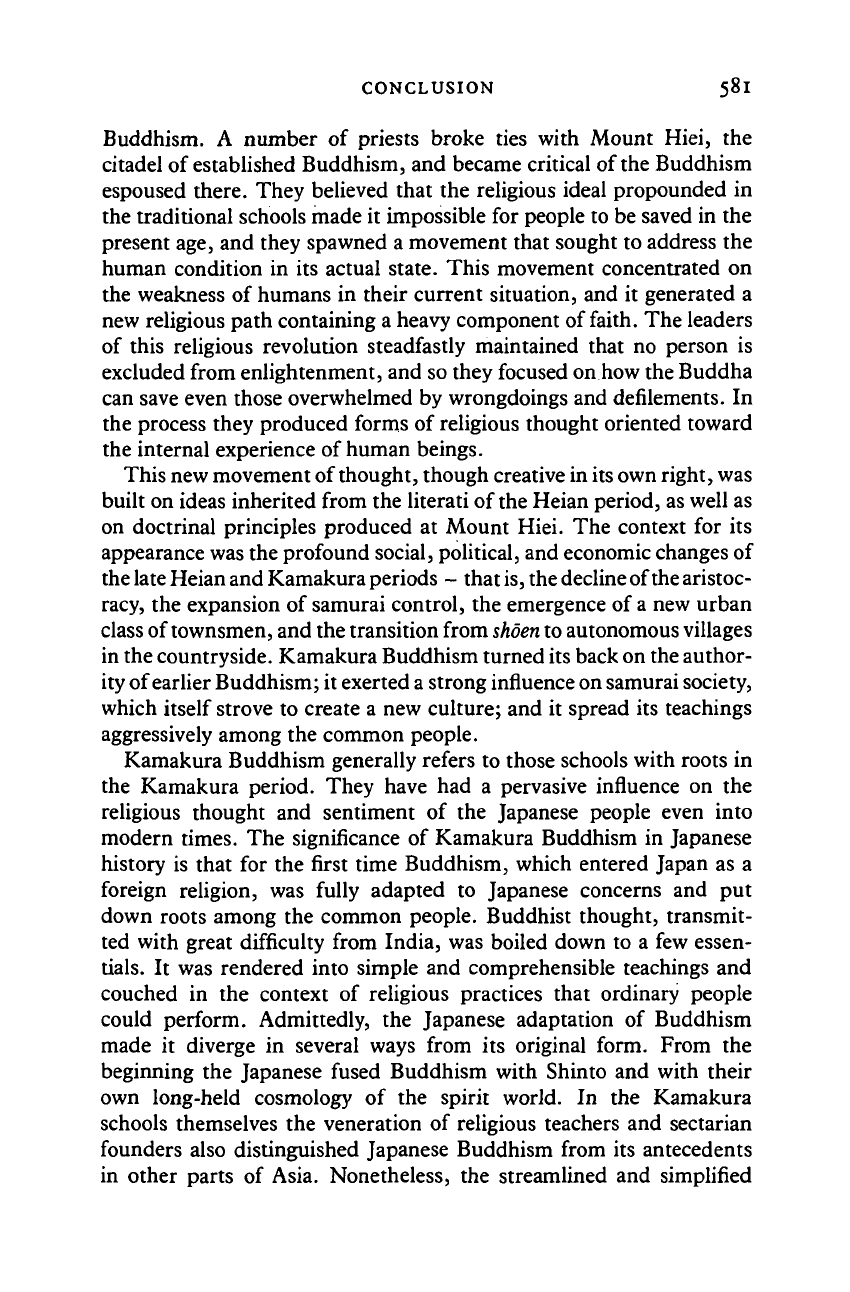
CONCLUSION 58l
Buddhism. A number of priests broke ties with Mount Hiei, the
citadel of established Buddhism, and became critical of the Buddhism
espoused there. They believed that the religious ideal propounded in
the traditional schools made it impossible for people to be saved in the
present age, and they spawned a movement that sought to address the
human condition in its actual state. This movement concentrated on
the weakness of humans in their current situation, and it generated a
new religious path containing a heavy component of faith. The leaders
of this religious revolution steadfastly maintained that no person is
excluded from enlightenment, and so they focused on how the Buddha
can save even those overwhelmed by wrongdoings and defilements. In
the process they produced forms of religious thought oriented toward
the internal experience of human beings.
This new movement of thought, though creative in
its
own right, was
built on ideas inherited from the literati of
the
Heian period, as well as
on doctrinal principles produced at Mount Hiei. The context for its
appearance was the profound social, political, and economic changes of
the
late
Heian and Kamakura periods - that
is,
the
decline of the aristoc-
racy, the expansion of samurai control, the emergence of
a
new urban
class of townsmen, and the transition from
shoen to
autonomous villages
in the countryside. Kamakura Buddhism turned its back on the author-
ity of earlier Buddhism; it exerted
a
strong influence on samurai society,
which itself strove to create a new culture; and it spread its teachings
aggressively among the common people.
Kamakura Buddhism generally refers to those schools with roots in
the Kamakura period. They have had a pervasive influence on the
religious thought and sentiment of the Japanese people even into
modern times. The significance of Kamakura Buddhism in Japanese
history is that for the first time Buddhism, which entered Japan as a
foreign religion, was fully adapted to Japanese concerns and put
down roots among the common people. Buddhist thought, transmit-
ted with great difficulty from India, was boiled down to a few essen-
tials.
It was rendered into simple and comprehensible teachings and
couched in the context of religious practices that ordinary people
could perform. Admittedly, the Japanese adaptation of Buddhism
made it diverge in several ways from its original form. From the
beginning the Japanese fused Buddhism with Shinto and with their
own long-held cosmology of the spirit world. In the Kamakura
schools themselves the veneration of religious teachers and sectarian
founders also distinguished Japanese Buddhism from its antecedents
in other parts of Asia. Nonetheless, the streamlined and simplified
Cambridge Histories Online © Cambridge University Press, 2008
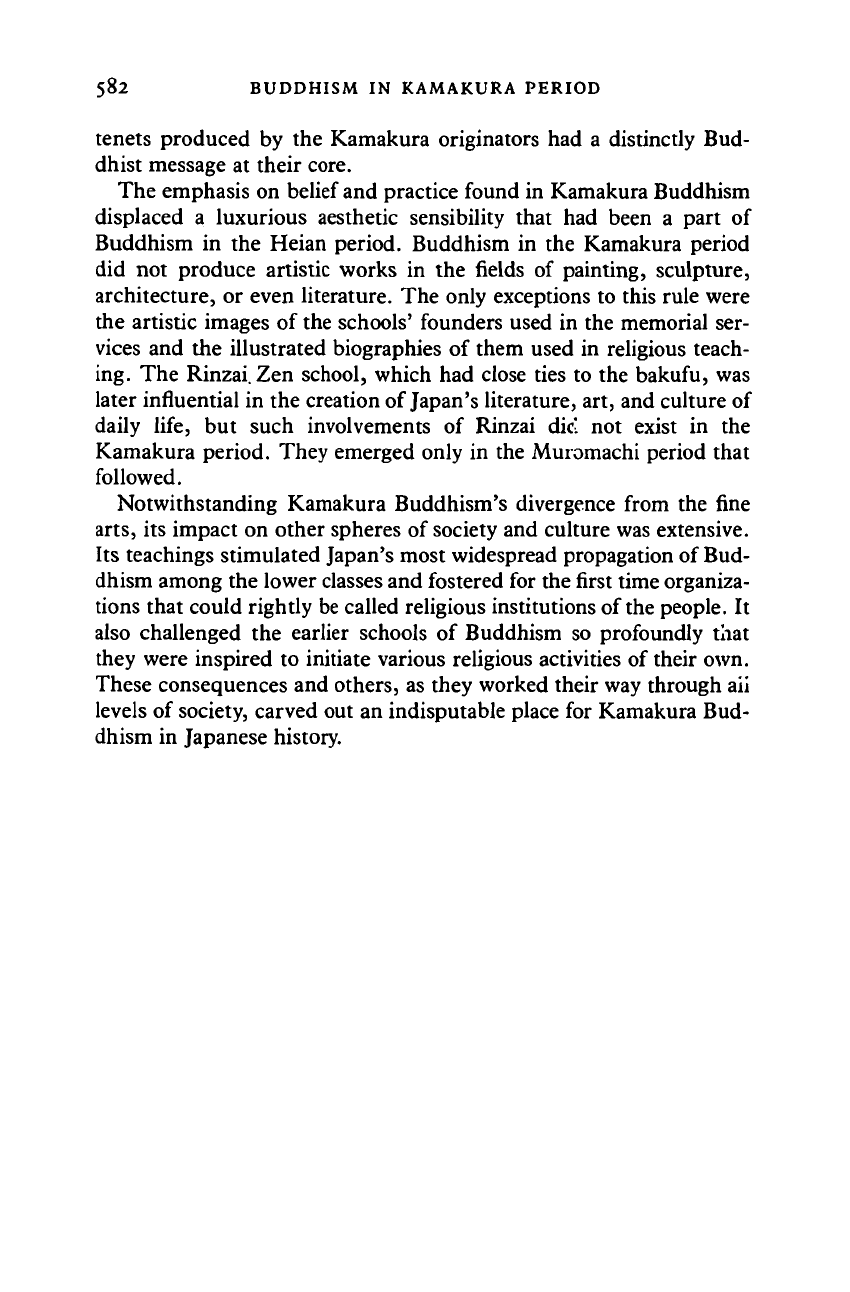
582 BUDDHISM IN KAMAKURA PERIOD
tenets produced by the Kamakura originators had a distinctly Bud-
dhist message at their core.
The emphasis on belief and practice found in Kamakura Buddhism
displaced a luxurious aesthetic sensibility that had been a part of
Buddhism in the Heian period. Buddhism in the Kamakura period
did not produce artistic works in the fields of painting, sculpture,
architecture, or even literature. The only exceptions to this rule were
the artistic images of the schools' founders used in the memorial ser-
vices and the illustrated biographies of them used in religious teach-
ing. The
Rinzai.
Zen school, which had close ties to the bakufu, was
later influential in the creation of Japan's literature, art, and culture of
daily life, but such involvements of Rinzai did not exist in the
Kamakura period. They emerged only in the Muromachi period that
followed.
Notwithstanding Kamakura Buddhism's divergence from the fine
arts,
its impact on other spheres of society and culture was extensive.
Its teachings stimulated Japan's most widespread propagation of Bud-
dhism among the lower classes and fostered for the first time organiza-
tions that could rightly be called religious institutions of
the
people. It
also challenged the earlier schools of Buddhism so profoundly that
they were inspired to initiate various religious activities of their own.
These consequences and others, as they worked their way through aii
levels of society, carved out an indisputable place for Kamakura Bud-
dhism in Japanese history.
Cambridge Histories Online © Cambridge University Press, 2008
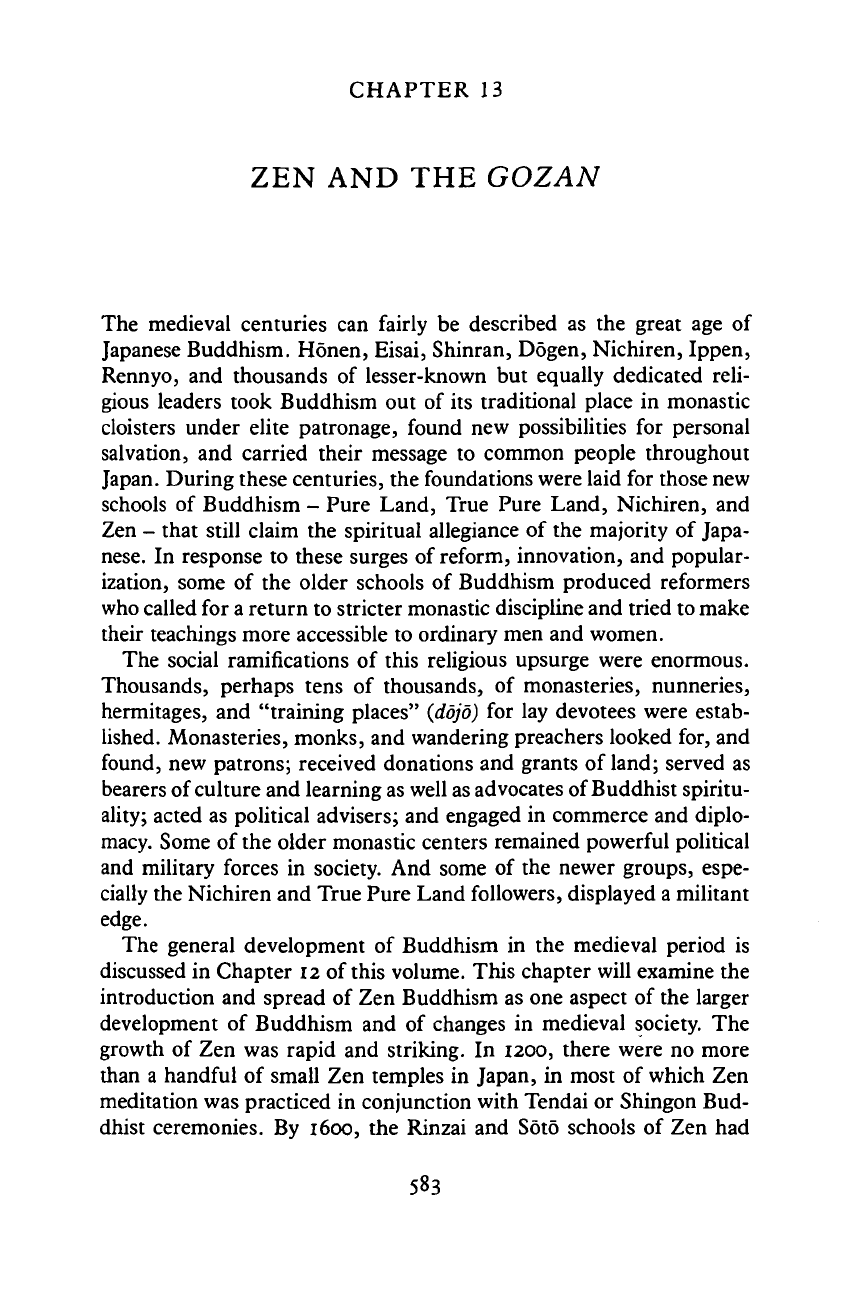
CHAPTER 13
ZEN AND THE GOZAN
The medieval centuries can fairly be described as the great age of
Japanese Buddhism. Honen, Eisai, Shinran, Dogen, Nichiren, Ippen,
Rennyo, and thousands of lesser-known but equally dedicated reli-
gious leaders took Buddhism out of its traditional place in monastic
cloisters under elite patronage, found new possibilities for personal
salvation, and carried their message to common people throughout
Japan. During these centuries, the foundations were laid for those new
schools of Buddhism - Pure Land, True Pure Land, Nichiren, and
Zen - that still claim the spiritual allegiance of the majority of Japa-
nese.
In response to these surges of reform, innovation, and popular-
ization, some of the older schools of Buddhism produced reformers
who called for a return to stricter monastic discipline and tried to make
their teachings more accessible to ordinary men and women.
The social ramifications of this religious upsurge were enormous.
Thousands, perhaps tens of thousands, of monasteries, nunneries,
hermitages, and "training places" (dojo) for lay devotees were estab-
lished. Monasteries, monks, and wandering preachers looked for, and
found, new patrons; received donations and grants of land; served as
bearers of culture and learning as well as advocates of Buddhist spiritu-
ality; acted as political advisers; and engaged in commerce and diplo-
macy. Some of the older monastic centers remained powerful political
and military forces in society. And some of the newer groups, espe-
cially the Nichiren and True Pure Land followers, displayed a militant
edge.
The general development of Buddhism in the medieval period is
discussed in Chapter 12 of this volume. This chapter will examine the
introduction and spread of Zen Buddhism as one aspect of the larger
development of Buddhism and of changes in medieval society. The
growth of Zen was rapid and striking. In 1200, there were no more
than a handful of small Zen temples in Japan, in most of which Zen
meditation was practiced in conjunction with Tendai or Shingon Bud-
dhist ceremonies. By 1600, the Rinzai and Soto schools of Zen had
583
Cambridge Histories Online © Cambridge University Press, 2008
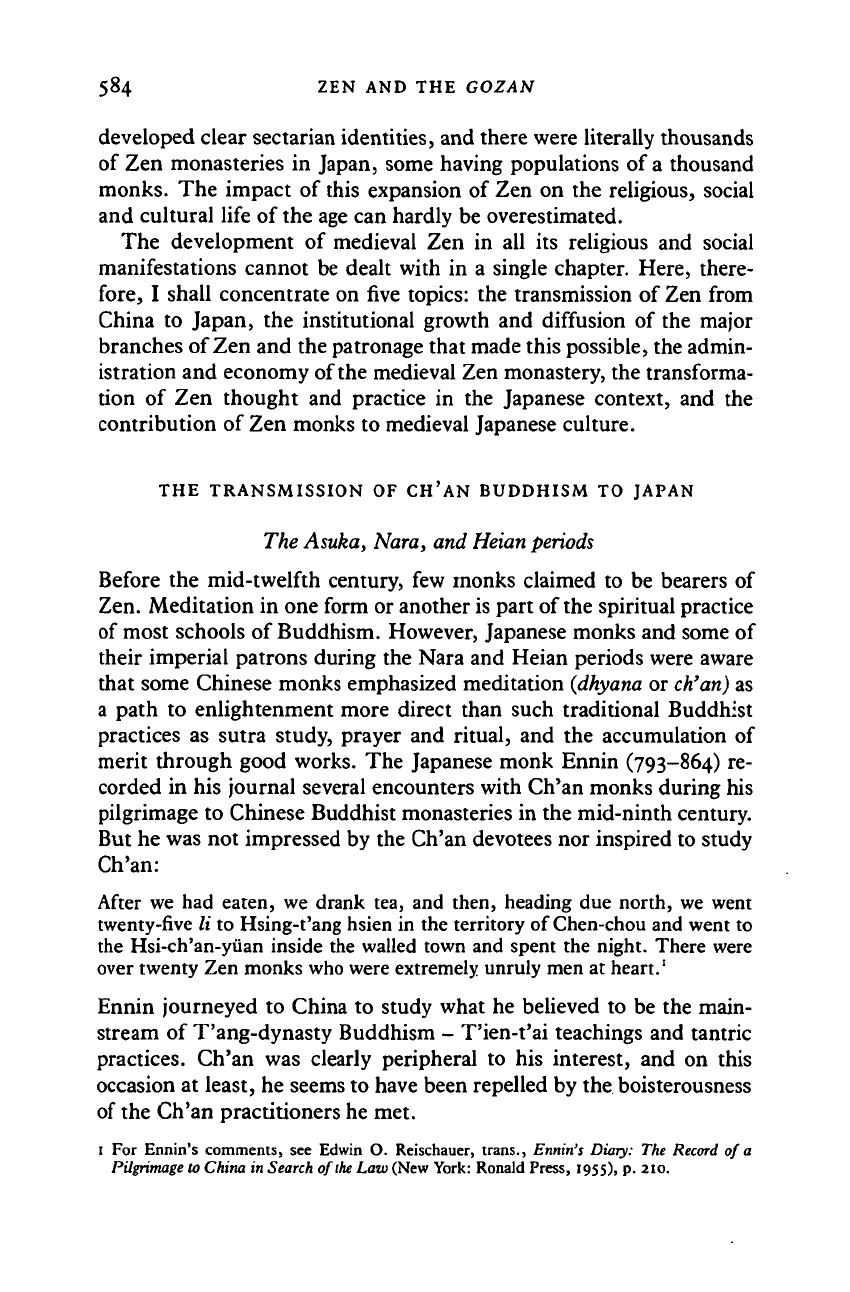
584 ZEN AND THE GOZAN
developed clear sectarian identities, and there were literally thousands
of Zen monasteries in Japan, some having populations of a thousand
monks. The impact of this expansion of Zen on the religious, social
and cultural life of the age can hardly be overestimated.
The development of medieval Zen in all its religious and social
manifestations cannot be dealt with in a single chapter. Here, there-
fore,
I shall concentrate on five topics: the transmission of Zen from
China to Japan, the institutional growth and diffusion of the major
branches of Zen and the patronage that made this possible, the admin-
istration and economy of the medieval Zen monastery, the transforma-
tion of Zen thought and practice in the Japanese context, and the
contribution of Zen monks to medieval Japanese culture.
THE TRANSMISSION OF CH'AN BUDDHISM TO JAPAN
The Asuka, Nara, and Heian periods
Before the mid-twelfth century, few monks claimed to be bearers of
Zen. Meditation in one form or another is part of the spiritual practice
of most schools of Buddhism. However, Japanese monks and some of
their imperial patrons during the Nara and Heian periods were aware
that some Chinese monks emphasized meditation
(dhyana
or
ch'an)
as
a path to enlightenment more direct than such traditional Buddhist
practices as sutra study, prayer and ritual, and the accumulation of
merit through good works. The Japanese monk Ennin (793-864) re-
corded in his journal several encounters with Ch'an monks during his
pilgrimage to Chinese Buddhist monasteries in the mid-ninth century.
But he was not impressed by the Ch'an devotees nor inspired to study
Ch'an:
After we had eaten, we drank tea, and then, heading due north, we went
twenty-five li to Hsing-t'ang hsien in the territory of Chen-chou and went to
the Hsi-ch'an-yiian inside the walled town and spent the night. There were
over twenty Zen monks who were extremely unruly men at heart.
1
Ennin journeyed to China to study what he believed to be the main-
stream of T'ang-dynasty Buddhism - T'ien-t'ai teachings and tantric
practices. Ch'an was clearly peripheral to his interest, and on this
occasion at least, he seems to have been repelled by the boisterousness
of the Ch'an practitioners he met.
1 For Ennin's comments, see Edwin O. Reischauer, trans., Ennin's Diary: The Record of a
Pilgrimage to China in Search of
the
Law (New York: Ronald Press, 1955), p. 210.
Cambridge Histories Online © Cambridge University Press, 2008
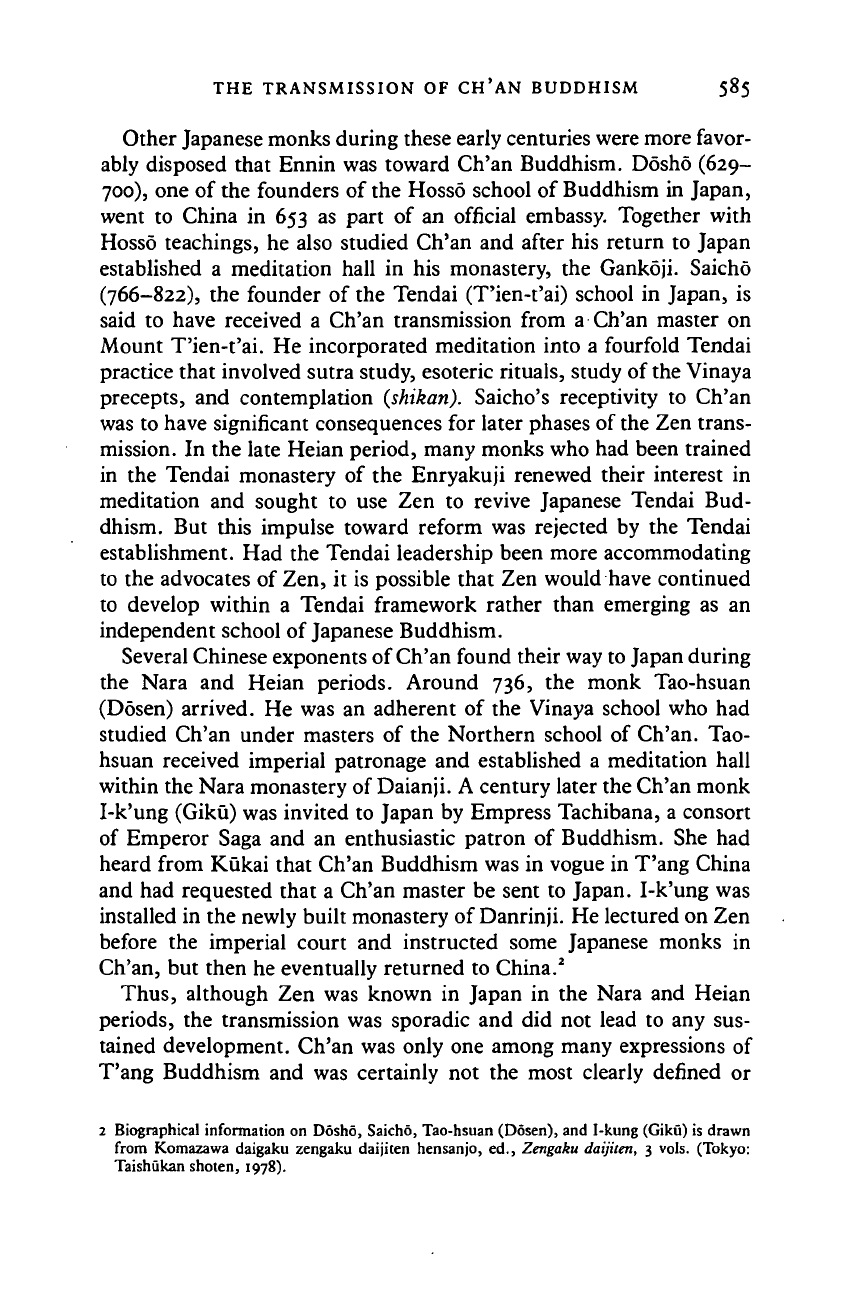
THE TRANSMISSION OF
CH'AN
BUDDHISM 585
Other Japanese monks during these early centuries were more favor-
ably disposed that Ennin was toward Ch'an Buddhism. Dosho (629-
700),
one of the founders of the Hosso school of Buddhism in Japan,
went to China in 653 as part of an official embassy. Together with
Hosso teachings, he also studied Ch'an and after his return to Japan
established a meditation hall in his monastery, the Gankoji. Saicho
(766-822), the founder of the Tendai (T'ien-t'ai) school in Japan, is
said to have received a Ch'an transmission from a Ch'an master on
Mount T'ien-t'ai. He incorporated meditation into a fourfold Tendai
practice that involved sutra study, esoteric rituals, study of the Vinaya
precepts, and contemplation (shikan). Saicho's receptivity to Ch'an
was to have significant consequences for later phases of the Zen trans-
mission. In the late Heian period, many monks who had been trained
in the Tendai monastery of the Enryakuji renewed their interest in
meditation and sought to use Zen to revive Japanese Tendai Bud-
dhism. But this impulse toward reform was rejected by the Tendai
establishment. Had the Tendai leadership been more accommodating
to the advocates of Zen, it is possible that Zen would have continued
to develop within a Tendai framework rather than emerging as an
independent school of Japanese Buddhism.
Several Chinese exponents of Ch'an found their way to Japan during
the Nara and Heian periods. Around 736, the monk Tao-hsuan
(Dosen) arrived. He was an adherent of the Vinaya school who had
studied Ch'an under masters of the Northern school of Ch'an. Tao-
hsuan received imperial patronage and established a meditation hall
within the Nara monastery of Daianji. A century later the Ch'an monk
I-k'ung (Giku) was invited to Japan by Empress Tachibana, a consort
of Emperor Saga and an enthusiastic patron of Buddhism. She had
heard from Kukai that Ch'an Buddhism was in vogue in T'ang China
and had requested that a Ch'an master be sent to Japan. I-k'ung was
installed in the newly built monastery of Danrinji. He lectured on Zen
before the imperial court and instructed some Japanese monks in
Ch'an, but then he eventually returned to China.
2
Thus,
although Zen was known in Japan in the Nara and Heian
periods, the transmission was sporadic and did not lead to any sus-
tained development. Ch'an was only one among many expressions of
T'ang Buddhism and was certainly not the most clearly defined or
2 Biographical information on Dosho, Saicho, Tao-hsuan (Dosen), and I-kung (Giku) is drawn
from Komazawa daigaku zengaku daijiten hensanjo, ed., Zengaku daijiien, 3 vols. (Tokyo:
Taishukan shoten, 1978).
Cambridge Histories Online © Cambridge University Press, 2008
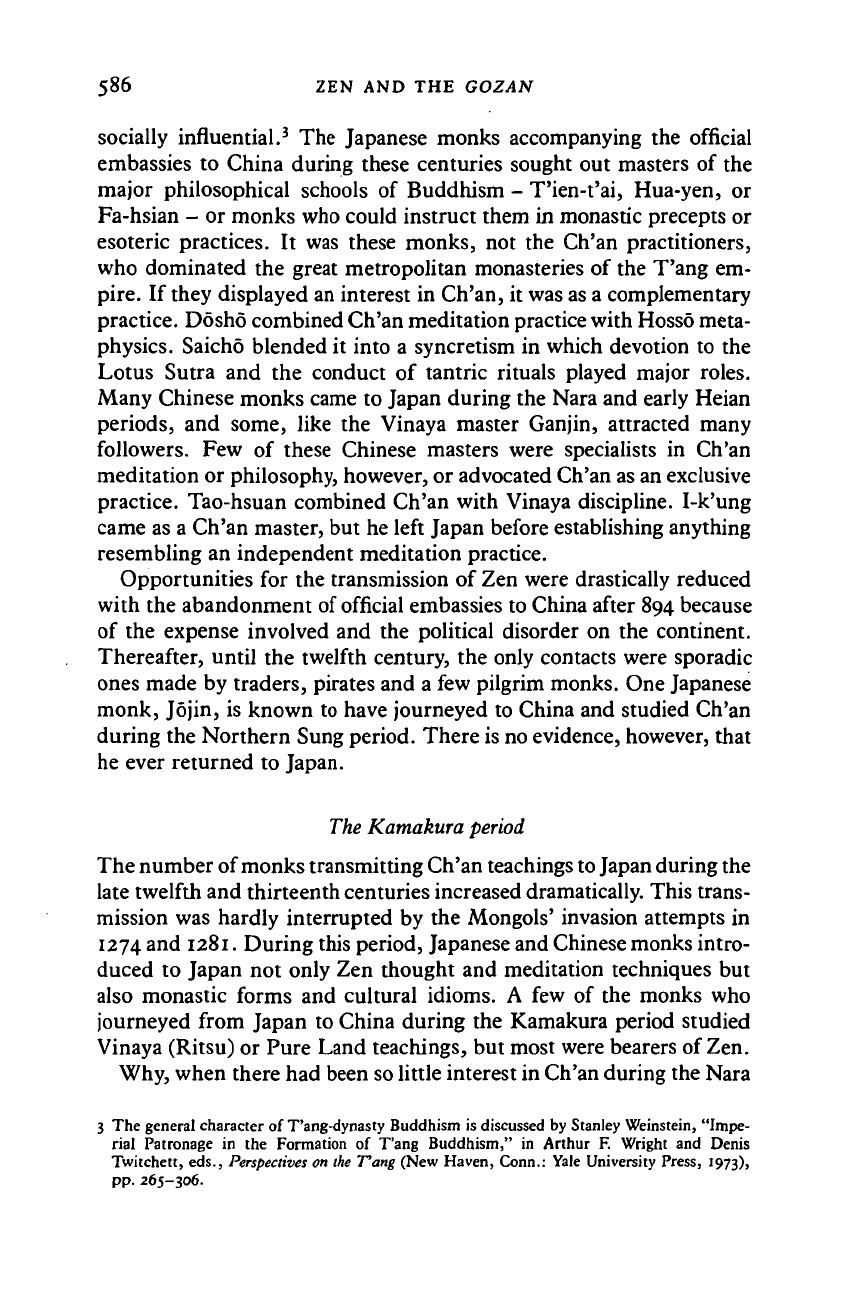
586 ZEN AND THE GOZAN
socially influential.
3
The Japanese monks accompanying the official
embassies to China during these centuries sought out masters of the
major philosophical schools of Buddhism - T'ien-t'ai, Hua-yen, or
Fa-hsian - or monks who could instruct them in monastic precepts or
esoteric practices. It was these monks, not the Ch'an practitioners,
who dominated the great metropolitan monasteries of the T'ang em-
pire.
If they displayed an interest in Ch'an, it was as a complementary
practice. Dosho combined Ch'an meditation practice with Hosso meta-
physics. Saicho blended it into a syncretism in which devotion to the
Lotus Sutra and the conduct of tantric rituals played major roles.
Many Chinese monks came to Japan during the Nara and early Heian
periods, and some, like the Vinaya master Ganjin, attracted many
followers. Few of these Chinese masters were specialists in Ch'an
meditation or philosophy, however, or advocated Ch'an as an exclusive
practice. Tao-hsuan combined Ch'an with Vinaya discipline. I-k'ung
came as a Ch'an master, but he left Japan before establishing anything
resembling an independent meditation practice.
Opportunities for the transmission of Zen were drastically reduced
with the abandonment of official embassies to China after 894 because
of the expense involved and the political disorder on the continent.
Thereafter, until the twelfth century, the only contacts were sporadic
ones made by traders, pirates and a few pilgrim monks. One Japanese
monk, Jojin, is known to have journeyed to China and studied Ch'an
during the Northern Sung period. There is no evidence, however, that
he ever returned to Japan.
The Kamakura
period
The number of monks transmitting Ch'an teachings
to
Japan during the
late twelfth and thirteenth centuries increased dramatically. This trans-
mission was hardly interrupted by the Mongols' invasion attempts in
1274 and
1281.
During this period, Japanese and Chinese monks intro-
duced to Japan not only Zen thought and meditation techniques but
also monastic forms and cultural idioms. A few of the monks who
journeyed from Japan to China during the Kamakura period studied
Vinaya (Ritsu) or Pure Land teachings, but most were bearers of Zen.
Why, when there had been so little interest in Ch'an during the Nara
3 The general character of T'ang-dynasty Buddhism is discussed by Stanley Weinstein, "Impe-
rial Patronage in the Formation of
T'ang
Buddhism," in Arthur F. Wright and Denis
Twitchett, eds., Perspectives on the
T'ang
(New Haven, Conn.: Yale University Press, 1973),
pp.
265-306.
Cambridge Histories Online © Cambridge University Press, 2008
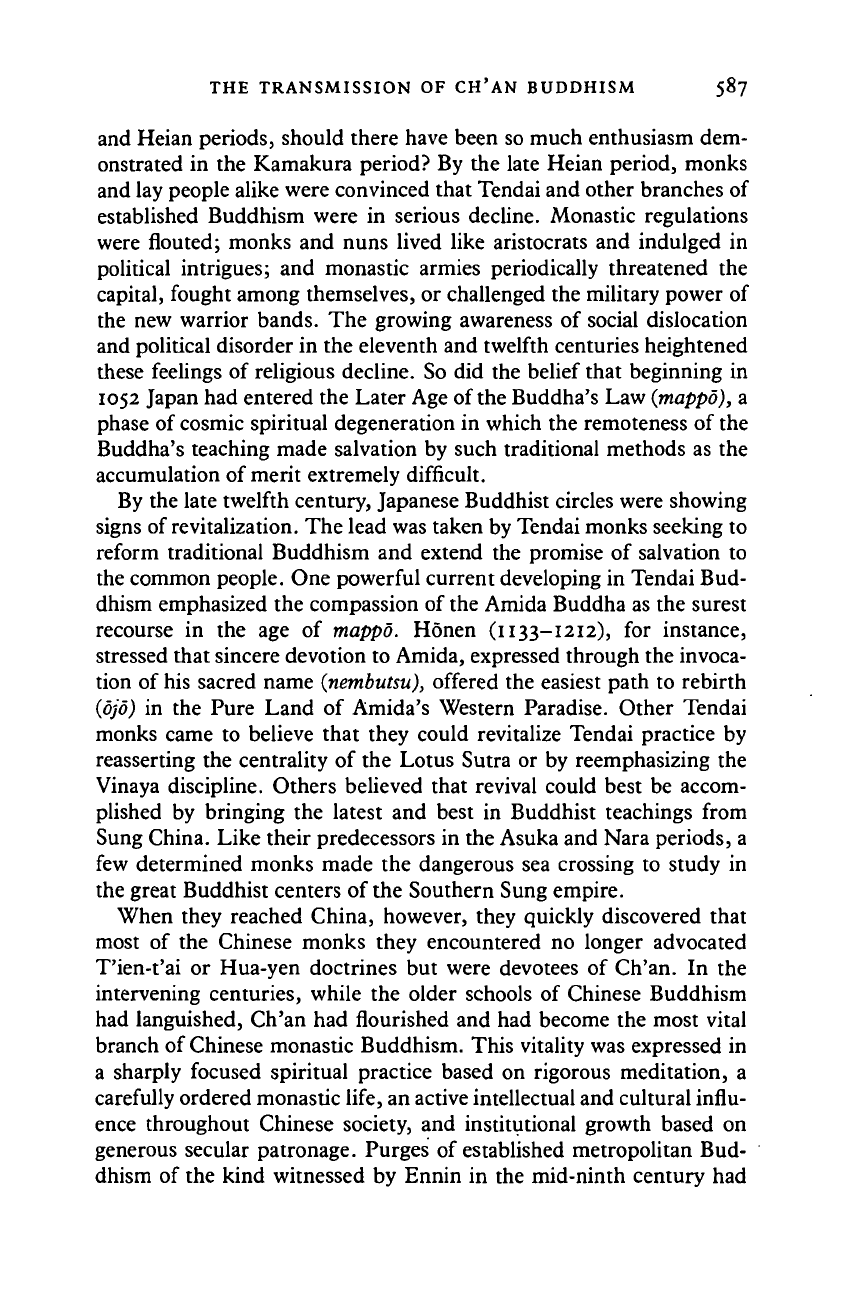
THE TRANSMISSION OF CH'AN BUDDHISM 587
and Heian periods, should there have been so much enthusiasm dem-
onstrated in the Kamakura period? By the late Heian period, monks
and lay people alike were convinced that Tendai and other branches of
established Buddhism were in serious decline. Monastic regulations
were flouted; monks and nuns lived like aristocrats and indulged in
political intrigues; and monastic armies periodically threatened the
capital, fought among themselves, or challenged the military power of
the new warrior bands. The growing awareness of social dislocation
and political disorder in the eleventh and twelfth centuries heightened
these feelings of religious decline. So did the belief that beginning in
1052 Japan had entered the Later Age of the Buddha's Law (mappo), a
phase of cosmic spiritual degeneration in which the remoteness of the
Buddha's teaching made salvation by such traditional methods as the
accumulation of merit extremely difficult.
By the late twelfth century, Japanese Buddhist circles were showing
signs of revitalization. The lead was taken by Tendai monks seeking to
reform traditional Buddhism and extend the promise of salvation to
the common people. One powerful current developing in Tendai Bud-
dhism emphasized the compassion of the Amida Buddha as the surest
recourse in the age of mappo. Honen (1133-1212), for instance,
stressed that sincere devotion to Amida, expressed through the invoca-
tion of his sacred name (nembutsu), offered the easiest path to rebirth
(pjo) in the Pure Land of Amida's Western Paradise. Other Tendai
monks came to believe that they could revitalize Tendai practice by
reasserting the centrality of the Lotus Sutra or by reemphasizing the
Vinaya discipline. Others believed that revival could best be accom-
plished by bringing the latest and best in Buddhist teachings from
Sung China. Like their predecessors in the Asuka and Nara periods, a
few determined monks made the dangerous sea crossing to study in
the great Buddhist centers of the Southern Sung empire.
When they reached China, however, they quickly discovered that
most of the Chinese monks they encountered no longer advocated
T'ien-t'ai or Hua-yen doctrines but were devotees of Ch'an. In the
intervening centuries, while the older schools of Chinese Buddhism
had languished, Ch'an had flourished and had become the most vital
branch of Chinese monastic Buddhism. This vitality was expressed in
a sharply focused spiritual practice based on rigorous meditation, a
carefully ordered monastic life, an active intellectual and cultural influ-
ence throughout Chinese society, and institutional growth based on
generous secular patronage. Purges of established metropolitan Bud-
dhism of the kind witnessed by Ennin in the mid-ninth century had
Cambridge Histories Online © Cambridge University Press, 2008

588 ZEN AND THE GOZAN
left Ch'an and Pure Land communities - with their provincial roots,
loose organization, and relative lack of wealth or reputation for
wealth - virtually unscathed. In fact, by attacking established Bud-
dhism as alien, opulent, and antisocial, the purges helped clear the
way for the spread of Ch'an and Pure Land teachings and practices
that could easily be reconciled with Chinese sensibilities. Even if they
had not impressed the Japanese monks, T'ang Ch'an masters like Ma-
tsu (709-88) ,and Lin-chi (d. 867) had attracted able monks and in-
trigued many laypersons through their direct approach, cryptic re-
sponses, and vigorous advocacy of the possibility of immediate enlight-
enment through meditation and self-negation.
4
In the centuries follow-
ing the collapse of the T'ang dynasty, while Pure Land devotion
spread widely at the popular level, Ch'an won the support of large
numbers of monks, literati, and provincial military governors:
With the diffusion of political power after the An Lu-shan Rebellion, the
military governors came to share with the imperial court the patronage of
Buddhism. The governors and the men around them were attracted to the
ideas of the school of meditation (Ch'an), and this school flourished in many
provincial centers.
5
Thus,
monasteries that had once been filled with T'ien-t'ai, Lii
(Ritsu), Fa-hsiang, or Hua-yen monks were now dominated by Ch'an
monks and headed by Ch'an masters. During the Sung dynasty, some
thirty Ch'an centers thoughout the empire were organized in a hierar-
chy, culminating in five great monasteries, cr mountains
(wu-shan),
in
Hangchow. These monasteries had great wealth and prestige. Of
course, together with official sponsorship went alignment with the
secular bureaucracy. The lives of the mcnks were carefully regulated,
and the appointments of their abbots were subject to official confirma-
tion. It was to these thriving Ch'aa rr.anasteries in and around
Hangchow and the lower Yangtze River region that Japanese monks
came in the late twelfth and thirteenth centuries.
6
When they enrolled in the monks' hails of these Chinese monaster-
ies and recovered from their surprise at the pervasiveness of Ch'an, the
Japanese monks found that they had much to learn. The Ch'an teach-
ings that I-K'ung introduced to Japan during the T'ang dynasty had
4 The growth of Ch'an Buddhism is introduced by Heinrich Dumoulin, A History of Zen
Buddhism (New York: Pantheon, 1963).
5 Wright and Twitchett, eds.,
Perspectives on
the Tang, p. 21.
6 Brief discussions of the role of
Ch'an
Buddhism in Sung-dynasty society can be found in Araki
Kengo, "Zen," in Kubo Noritada and Nishi Junzo, eds., Shukyo, vol. 6 of
Chugoku
bunka
sosho
(Tokyo: Taishukan shoten, 1968), pp. 106-114; and Tamamura Takeji, "Zen," in Bito
Masahide, ed., Chugoku bunka
to Chugoku
(Tokyo: Taishukan shoten, 1968), pp. 151—71.
Cambridge Histories Online © Cambridge University Press, 2008
